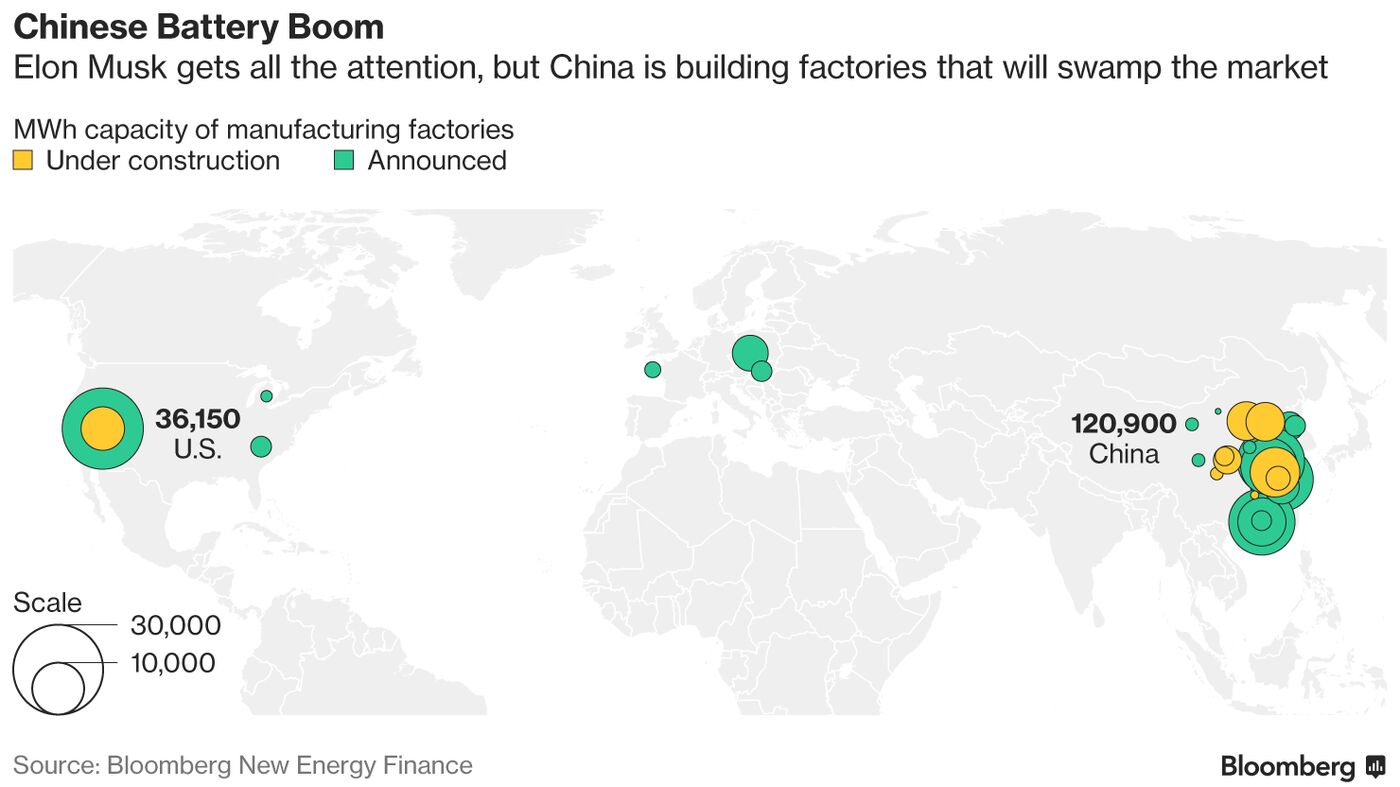10 Battery Gigafactories Are Now in the Works. And Elon Musk May Add 4 More
10 Battery Gigafactories Are Now in the Works. And Elon Musk May Add 4 More
Could a gigafactory glut lead to oversupply?
by Jason Deign
June 29, 2017
Gigafactory announcements have been trending in recent months, with plans for at least 10 new plants revealed in the last six months. Half a dozen have been planned in the last month alone.
In Germany, for example, the Daimler subsidiary Accumotive laid the foundation for a $550 million plant designed to take annual lithium-ion battery production from its current level of 80,000 units up to around 320,000.
<snip>
The most aggressive gigafactory plans, however, remain with the company that came up with the concept. Tesla’s Elon Musk has said he will announce “probably four” new gigafactories this year. One has long been slated for Europe, and another has been confirmed to be in the works in Shanghai, China.
The recent announcements follow at least five gigafactory proposals put forward for Europe before the end of last year, including facilities in Sweden, Hungary and Poland. Not all the new plants will focus on lithium-ion batteries, though.
More at https://www.greentechmedia.com/articles/read/10-battery-gigafactories-are-now-in-progress-and-musk-may-add-4-more?utm_source=Daily&utm_medium=Newsletter&utm_campaign=GTMDaily
kristopher
(29,798 posts)China Is About to Bury Elon Musk in Batteries
Factories are adding enough capacity to power the equivalent of nearly 1.5 million Model S vehicles
(That is 1.5M annually - K)

https://www.bloomberg.com/news/articles/2017-06-28/china-is-about-to-bury-elon-musk-in-batteries
kristopher
(29,798 posts)McKinsey: Cheaper batteries present imminent threat of load defection for utilities
AUTHOR Peter Maloney@TopFloorPower
June 30, 2017
Dive Brief:
Continued energy storage cost declines present a growing threat of disruption for utility business models, a new study from McKinsey & Co. finds.
The study reports energy storage is already economical for many commercial customers at today’s prices and that with the paring back of incentives such as net metering in many states, combining solar power with energy storage is beginning to be attractive for some households.
Continued cost declines are moving energy storage from niche applications, such as grid balancing, to broader uses such as replacing conventional power generators for reliability, providing power-quality services, and supporting renewables integration, according to McKinsey.
Dive Insight:
Energy storage prices are falling faster than anyone expected, with battery costs down to less than $230/kWh in 2016 from almost $1,000/kWh in 2010, McKinsey noted.
The cost declines are being driven by a growing market for consumer electronics and demand for electric vehicles. In addition, companies in Asia, Europe, and the United States are building large factories to scale up for expected demand for lithium-ion batteries...
http://www.utilitydive.com/news/mckinsey-cheaper-batteries-present-imminent-threat-of-load-defection-for-u/446193/
McKinsey report in full:
June 2017
Battery storage: The next disruptive technology in the power sector
By David Frankel and Amy Wagner
http://www.mckinsey.com/business-functions/sustainability-and-resource-productivity/our-insights/battery-storage-the-next-disruptive-technology-in-the-power-sector
<snip>
net energy metering (NEM) refers to rules that allow excess power to be sold back to the grid at retail rates; and feed-in tariffs, which are guaranteed price adders for renewable power, have played an important role in expanding the global market for renewables. In the US states that have implemented such rules, NEM has proved to be a powerful incentive for consumers to install solar panels.
Would you like to learn more about our Electric Power & Natural Gas Practice?
Although it has been helpful for solar, NEM also has put utilities under pressure. It reduces demand because consumers make their own energy; that increases rates for the rest, as there are fewer bill payors to cover the fixed investment in the grid, which still provides backup reliability for the solar customers. The solar customers are paying for their own energy but not paying for the full reliability of being connected to the grid. The utilities’ response has been to design rates that reduce the incentive to install solar by moving to time-of-use pricing structures, implementing demand charges, or trying to reduce how much they pay customers for the electricity they produce that is exported to the grid.
However, in a low-cost storage environment, these rate structures are unlikely to be effective at mitigating load losses. This is because adding storage allows customers to shift solar generation away from exports to cover more of their own electricity needs; as a result, they continue to receive close to the full retail value of their solar generation. This presents a risk for widespread partial grid defection, in which customers choose to stay connected to the grid in order to have access to 24/7 reliability, but generate 80 to 90 percent of their own energy and use storage to optimize their solar for their own consumption.
We are already seeing this begin to play out in places where electricity costs are high and solar is widely available, such as Australia and Hawaii. On the horizon, it could occur in other solar-friendly markets, such as Arizona, California, Nevada, and New York (Exhibit 2). Many utility executives and industry experts thought the risk of load loss was overblown in the context of solar; the combination of solar plus storage, however, makes it much more difficult to defend against.
...<snip>....
http://www.mckinsey.com/business-functions/sustainability-and-resource-productivity/our-insights/battery-storage-the-next-disruptive-technology-in-the-power-sector
Much more, including discussion of how stacking the value derived from multiple uses of the same system works to make behind the meter storage more enticing. It includes a chart showing various applications for battery storage and the general value of those uses...